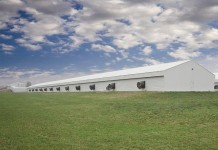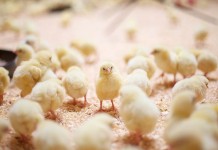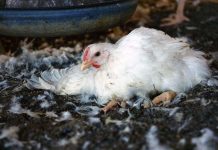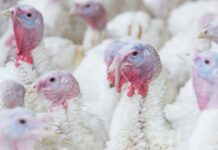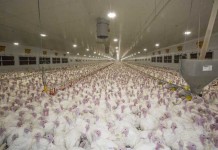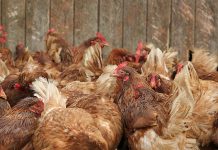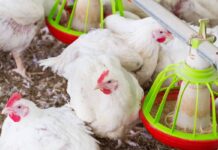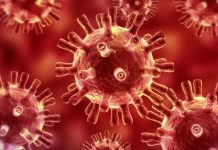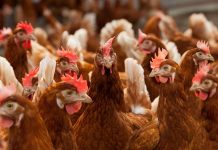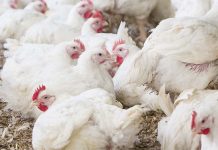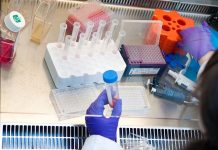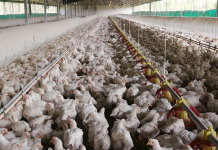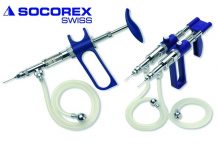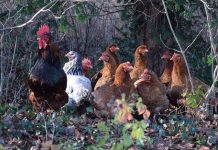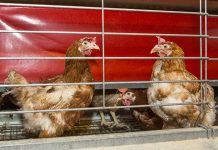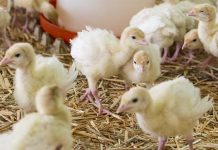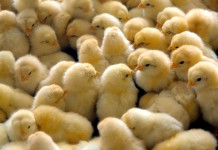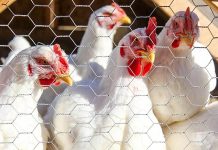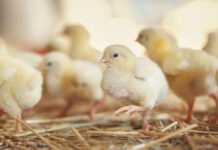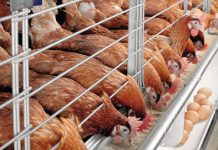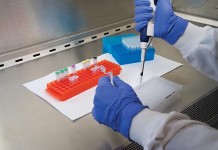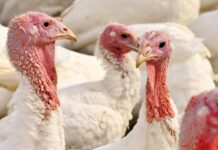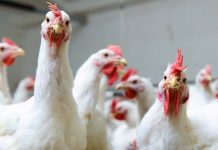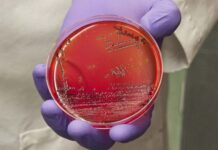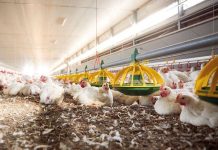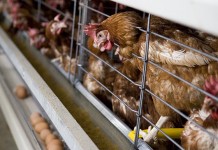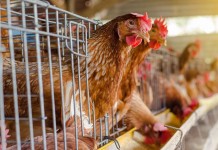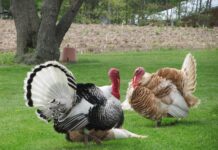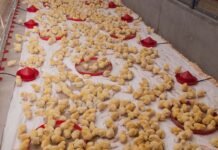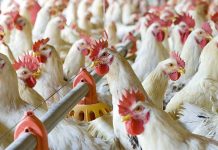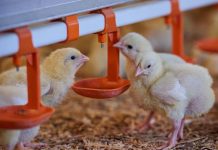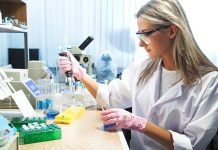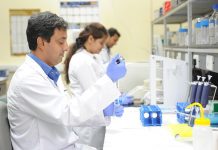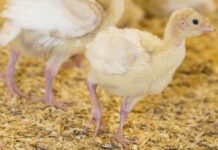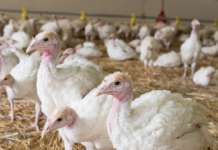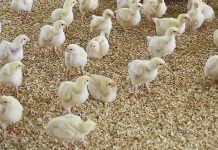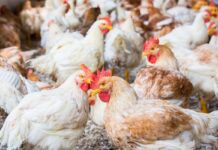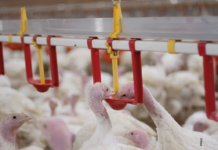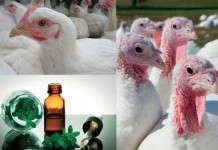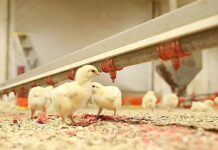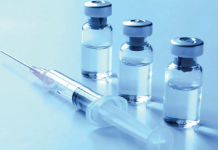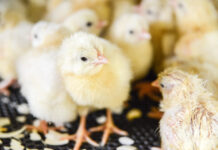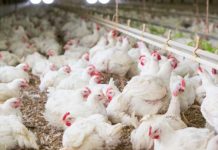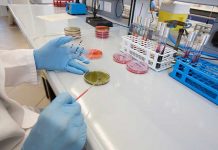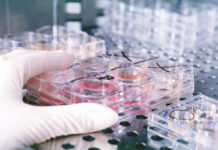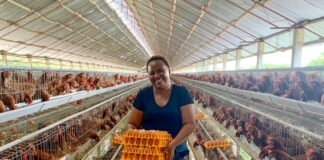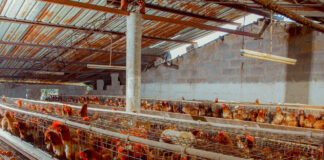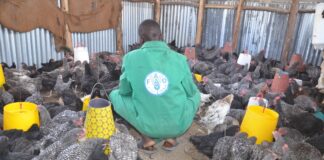Enhancing biosecurity using flow analysis and Danish entry concepts
The term Danish entry is commonly used to describe entryways to livestock buildings that help people enter barns in a relatively bio secure way...
Integrated Microfluidic Device for rapid Avian Influenza virus capture
Rapid detection of avian influenza virus (AIV) is highly desirable during outbreaks or routine AIV surveillance.
In this project, the preliminary results in developing a...
Backyard poultry flocks Salmonella spp. seroprevalence
As backyard poultry grows as a hobby in the United States there is an increased worry that poultry will become infected with Salmonella spp....
Concurrent infection of Histomonas meleagridis and Eimeria meleagridis in a turkey flock
Blackhead disease (histomoniasis) in turkeys is one of the protozoan diseases sporadically documented in commercial turkey production facilities. Histomoniasis may induce mild, moderate, or...
Future of Blackhead Disease in poultry
A turkey health survey of US veterinarians in turkey production ranked blackhead position #13 (#11 prior year) compared to #22 in 2006; the survey...
Managing CO2 and fresh air to optimise hatchability
Last year I was invited to a layer hatchery that was reporting slightly lower hatchability than its sister hatcheries, despite using eggs from the...
Managing coccidiosis in birds raised without antibiotics
For poultry producers to make a profit they must have healthy, uniform sized birds, make sure there are no real or assumed human health...
Pirbright’s new Avian Influenza vaccine
An improved poultry influenza vaccine has been developed by researchers from The Pirbright Institute. The potential vaccine triggers a rapid immune response which protects...
Rapid in vitro antimicrobial screening assay against Campylobacter
Research was undertaken to adapt a multi-well antimicrobial assay as a fast and reliable method to screen large numbers of plant extract treatments against...
Incorporating an essential oil and saponin blend as part of an effective coccidiosis management...
Coccidiosis continues to be a top challenge in the poultry industry and growing evidence of reduced sensitivity to traditional anticoccidials like ionophores and chemicals...
Pirbright’s livestock coronavirus research
The Pirbright Institute is aware that misinformation regarding the Institute and its research is circulating on social media following an outbreak of a new...
Microbiological consequences of different housing systems for laying hens, with particular reference to Salmonella...
A significant proportion of human illnesses caused by Salmonella are linked to the consumption of contaminated eggs. In response, substantial government and private industry...
Obtaining the most benefit from an anticoccidial sensitivity test
The poultry industry has been using the same anticoccidial drugs for the prevention of coccidiosis for several decades. The last approval of a new...
Ability to detect Salmonella vs. Salmonella-Free in poultry processing
Poultry are sampled often for Salmonella during growout on the farm and throughout the processing plant. While on farm sampling is not currently a...
Case report: histomoniasis in broiler breeder pullets
Histomoniasis, commonly known as blackhead disease, is caused by an anerobic protozoan parasite, Histomonas meleagridis. Histomoniasis affects all gallinaceous birds and turkeys are the...
Boosting the cell-mediated immunity in chickens post-hatch via pre-hatch delivery of nucleic acids
Respiratory virus infections such as Avian Influenza, infectious laryngotracheitis and infectious bronchitis lead to high morbidity and mortality in chickens globally.
Given the limitations...
Understanding resistance to different Infectious Bronchitis virus genotypes
In previous experiments, we have challenged major histocompatibility complex (MHC) congenic chicken lines available at UC Davis with an infectious bronchitis virus (IBV) M41...
A multidisciplinary research approach on Avian Influenza in Italy
The Avian Influenza epidemic of 2016-2017 had been the largest in Europe in more than 10 years. The circulating virus was a Highly Pathogenic...
Research Rules Out Possible Kinky Back Prevention
USPOULTRY and the USPOULTRY Foundation announce the completion of a funded research project at North Carolina State University in Raleigh, N.C., in which researchers...
Use of injection syringes in the animal production industry
Animal health is an important factor to consider, as any disease outbreak can potentially have drastic economical consequences. For this reason, planning and preparing...
Infectious Coryza in vaccinated layers: are vaccines failing to protect?
During 2017 and 2018 Infectious Coryza was detected in several commercial vaccinated egg layer flocks in California. The Avibacterium paragallinarum strains isolated from infected...
DNA region in chickens identified for disease resistance
One region in the DNA explains a large difference in possible disease resistance betweenchickens. This was discovered by researchers of Wageningen University & Research...
Blackhead disease: development of molecular tests and an in vitro assay to identify reservoirs...
This research project developed diagnostic assays needed for advancing the understanding of blackhead disease. The article shows clearly how the disease most likely spreads...
Biosecurity measures and new vaccines to combat the spread of bird flu
The recent H5N6 bird flu outbreak is confined to the south of England, partly due to the introduction of an Avian Influenza Protection Zone...
Turkey arthritis reovirus. Diagnostic strategies
Avian reoviruses (ARVs). They are non-enveloped viruses of 70-80 nm size having an icosahedral symmetry. The viral genome has 10 segments of double stranded...
Evaluation of factors that affect susceptibility and control of reovirus-induced viral arthritis in broiler...
The USPOULTRY Foundation announces the completion of a funded research project at AviServe LLC in Newark, Del. (USA), that has revealed a new tool for...
Prevalence and antimicrobial resistance of thermophylic Campylobacters in poultry
Campylobacter spp. is a leading cause of foodborne diarrhea. The most common source of infection is contaminated food, mainly poultry meat.
The uncontrolled use of...
The manureshed concept: a solution to poultry litter nutrient recycling?
Surface waters in the United States are regularly assessed as a part of the Clean Water Act to determine whether the water quality protects...
Infectious Laryngotracheitis (ILT) outbreaks in laying hens in Konya province
Infectious laryngotracheitis (ILT) epidemic cases characterized with respiratory symptoms, hemorrhagic tracheitis and laryngitis findings were identified in laying hen’s enterprises in Konya province.
Ten Lohman-breed...
Collaborative regulatory approach can reduce antibiotic use in animal production
As global concern about the human health threat posed by antimicrobial resistance continues rises, governments continue to introduce legislation to curb antibiotic use in...
Pathogenesis of egg infections by Salmonella – First Part
Salmonella is an invasive bacterial genus and colonizes the gut of chickens, and systemically spreads to internal organs, including the reproductive tract, potentially leading...
Increasing standardization in real-time PCR diagnostics
How to use it with a modular system and its benefit to laboratory throughput.
The IDEXX RealPCR™ real-time PCR reagents aim to provide a new...
How Marek’s disease may directly affect the chicken immune system
Marek’s disease virus (MDV) causes disease in chickens and is estimated to cost the global poultry industry up to US $2 billion each year.
In...
Advantages and disadvantages of Coccidiosis control programs in poultry
Coccidiosis is a protozoan economic disease of poultry, in which around 80% of losses are due to mortality, reduced weight gain, inefficient feed conversion,...
Cochlosoma anatis in turkeys
A funded research project at North Carolina State University in Raleigh, N.C. evaluated the pathogenicity of Cochlosoma anatis. The research was made possible in...
Development of Multilocus sequence typing (MLST) for Mycoplasma gallisepticum
Mycoplasma gallisepticum (MG) is the most pathogenic avian mycoplasma species. It affects commercial, non-commercial poultry and wild birds. Current MG sequence typing methods rely...
Pathogenesis of egg infections by salmonella – Second Part
Early protection has been demonstrated after primary live vaccine administration early post-hatch but this effect is serotype-specific, while cross-protection between some serotypes has been...
Reducing antibiotic use without harming profitability is an actual possibility
Ten million people are at risk due to antibiotic resistance, ensures the “Antimicrobial Resistance Review” published by the United Kingdom government in 2014. Of...
Novel Approach Improves Poultry Welfare by Reducing Stress on Chickens
MSD Animal Health (known as Merck Animal Health within the United States and Canada) recently announced the launch of EXZOLT® (fluralaner), the first systemic...
Better than alternatives to antibiotics
Many poultry flocks require antibiotic treatment, if not every cycle, regularly. Antibiotic alternatives are in great demand, especially in the context of dysbiosis and...
Sample management and handling for diagnostic testing
Diagnostic testing is an important and widely used tool in commercial poultry husbandry. A key to best use of diagnostic testing, is to begin...
Targeted preharvest interventions against Salmonella in turkeys
Salmonella is a foodborne zoonotic pathogen prevalent in poultry production, including turkeys. The pathogen is a constant threat to human public health because of...
Coccidiosis control in broiler breeders with the use of vaccines by Aviagen®
Coccidiosis is a disease of the intestinal lining, produced by the invasion of the mucosal cells by a very prolific protozoan parasite of the...
How Necrotic Enteritis affects animal’ welfare and performance
Necrotic Enteritis (NE) affected flocks have poor enteric health and nutrient digestibility leading to decreased performance and increased excretion of nutrients.
Evidence suggests that...
Use of comparative genomics to identify vaccine candidates for Campylobacter Jejuni
Interventions to control and reduce the incidence of Campylobacter jejuni colonization in poultry is important in order to reduce the burden of foodborne illness in humans....
Research reveals method to improve Escherichia coli vaccines
A funded research project at the University of Georgia in Athens, Ga. was completed, in which researchers revealed a method to improve Escherichia coli...
Holistic view of intestinal health in poultry
Intestinal health is necessary to maintain efficient and sustainable gastrointestinal tract (GIT) physiology. The GIT has digestive, absorptive, metabolic, immunological and endocrinological functions.
This means...
Researchers characterize selected variant Avian Reovirus strains
USPOULTRY and the USPOULTRY Foundation announce the completion of a funded research project at the University of California, Davis, in which researchers looked to...
Future of coccidiosis management in turkeys
Coccidiosis is a disease that is caused by protozoan parasites that develop within the intestine of most domestic and wild animals and birds. Coccidia...
UK Veterinary Vaccinology Network
Veterinary researchers from around the world came together at this year’s joint UK & International Veterinary Vaccinology Network Conference on the 9-10 January 2019...
Compatibility of a new multi-strain probiotic with a live-attenuated Salmonella vaccine in chickens
A pilot study was undertaken to assess the compatibility of a new multistrain probiotic with a live-attenuated Salmonella Typhimurium (ST) vaccine. Experimental units were...
Researchers examine the role of APEC in turkey cellulitis
USPOULTRY and the USPOULTRY Foundation announce the completion of a funded research project at the University of Georgia in Athens, Georgia, in which researchers...
Infectious Bursal Disease antibody levels and viral load in commercial broiler chickens
Infectious bursal disease (IBD) disease is caused by infectious bursal disease virus (IBDV) of the genus Avibirna-viridae and family Birna-viridae. IBDV is found worldwide...
Linear Epitope Mapping of B-cell responses following immunization with Avian Reovirus S1133
Avian reovirus is a causative agents of tenosynovitis and viral arthritis. Commercially available reovirus vaccines do not protect against challenge with emerging variants associated...
Research shows how Infectious Laryngotracheitis can spread from vaccinated flocks
The research on how Infectious Laryngotracheitis can spread from vaccinated flocks was made possible in part by an endowing Foundation gift from Claxton Poultry...
Frontiers in human and veterinary antibody discovery
The Pirbright Institute hosted the inaugural Comparative Veterinary Immunology Group (CVIG) meeting Frontiers in Human and Veterinary Antibody discovery on 26 and 27 November,...
Pathological manifestations of highly pathogenic and predominant Eimeria species in turkeys
Coccidiosis is caused by intra-cellular enteric protozoan parasites of the genus Eimeria. Eimeria is a gastrointestinal parasite with a complex life cycle involving an...
Transcriptomic modifications caused by subclinical necrotic enteritis in broiler chickens
Phasing out of in-feed antibiotics in the poultry industry has caused necrotic enteritis (NE) to become a primary concern in commercial poultry production in...
Poultry expertise at IDEXX
In a rapidly evolving poultry production environment with fewer treatment options, disease prevention and identification are more important than ever. Reliable lab diagnostics play...
The challenges and future of poultry diagnostics
A review of the past helps to frame the future of poultry diagnostics. In the United States, the Land-Grant universities provided a fertile environment...
Host and microbial biomarkers for intestinal health and disease in broilers
New tools can be used to determine the gut health status of animals and to predict animal performance or to make a decision whether...
Role of dietary calcium in Necrotic Enteritis development and pathogenesis
USPOULTRY and the USPOULTRY Foundation announce the completion of a funded research project at Texas A&M University in College Station, Texas, in which the...
Optimizing immunization through proper vaccination in turkeys
When we talk about optimizing immunization through proper vaccination in commercial turkeys, we are really talking about optimizing drinking water vaccination when we think...
The role of feed additives in the protozoal diseases in poultry
Coccidiosis and histomoniasis are economically significant diseases in chickens and turkeys. Management, vaccination and medication are key tools in the control of these diseases...
Interrupting cholesterol pathway reduces Marek’s disease spread
In a new discovery, scientists from The Pirbright Institute confirm that cholesterol production and transport play a crucial role in how Marek’s disease virus...
Quality Control Audits of killed vaccination
Vaccination programs for breeders and egg layers include procedures with inactivated vaccines. Killed (inactivated) vaccines are used to prevent disease in the vaccinated bird...
Towards practical methods for assessing ILTV vaccine take
In response to ILTV outbreaks, live vaccines are typically administered at 7-14 days of age in drinking water via nipple drinkers which may not...
Bacterin usage
A good vaccination program, along with proper flock management and biosecurity, plays a key role in the health and productivity of broiler breeders. The...
A diagnostic laboratory perspective for pathogen detection
Detection of infectious diseases can generally be broken down into laboratory detection of the pathogen or detection of the immune response to the pathogen....
An alternative method to fight Avian Influenza Virus
A recent project was completed at the University of Iowa, Iowa City, Iowa, in which researchers developed a mobile system that can inactivate Avian...
NWO OTP grant awarded to WUR project aimed at head start for day-old chicks
The immune system of a chicken starts in the egg. Validated tools to assess how incubation conditions influence immune development are lacking. A new...
Profiling Salmonella serotypes through broiler processing
USPOULTRY and the USPOULTRY Foundation announce the completion of a funded research project at the University of Georgia in which researchers profiled Salmonella serotypes through broiler processing.
The...
Research examines novel next generation sequencing techniques
USPOULTRY and the USPOULTRY Foundation announce the completion of a funded research project at the University of Georgia in Athens, Georgia, in which researchers...
Alternatives to antibiotics in organic poultry
Organic poultry production is one of the fastest growing segments of organic agriculture with a 20% average annual increase since the establishment of the...
Salmonella prevention strategies and influences of sampling method selection
Multiple factors can influence both Salmonella prevalence and diversity of Salmonella serogroups detected from both pre and post-harvest samples. Sampling methodologies vary widely when...
Effect of difference doses of Newcastle disease vaccine immunization on broilers
Influence on growth performance, plasma variables and immune response
As a member of the Paramyxoviridae group, Newcastle disease virus (NDV) is the key causative agent...
Salmonella Reading in commercial turkeys. Why now and how?
Salmonella sp. is one of the most common bacteria associated with foodborne illness in humans. Each year in the United States, foodborne salmonellosis causes...
Gut health in poultry production: why, what and how
Gut health has become a dominant topic in the global poultry industry. But why did the topic emerge to become so important to the...
Infectious bronchitis virus (IBV) vaccines produced in eggs have unpredictable mutations
Scientists at The Pirbright Institute have shown that infectious bronchitis virus (IBV) vaccines produced in eggs have unpredictable mutations which may be prone to...
On-farm control of campylobacter
Campylobacteriosis, primarily caused by the consumption of contaminated chicken products, accounts for the majority of food poisoning cases in Europe and many other developed...


